Country Report: Mexico
Energy reform may be stealing the headlines in Mexico, but a rising regulatory authority, the beginnings of healthcare reform, and cost-competitive manufacturing are fueling future growth in the country’s pharma industry-for domestic and global players alike.
This sponsored supplement was produced by Focus Reports
Report Publisher: Ines Nandin
Project Director: Mariuca Georgescu
Journalist: Manuela D'Andrea
To read exclusive interviews, visit www.pharmaboardroom.com
MEXICO: BRINGING ENERGY TO HEALTH
While the recently-approved energy reform might have taken much of the international spotlight, there is much more going on in Mexico today. The recent structural reforms undertaken by Peña Nieto's government have one objective: restarting the engine of growth. The pharmaceutical industry is no exception to this. With a regulatory authority risen to become a reference in the region, a healthcare reform under way and cost-competitive manufacturing, the pharma sector in Mexico is paving the way to fuel future growth, for local and international players alike.

Photo Credit : Publisher
MEXICO READY, STEADY, GO!
While the global investment community has been eagerly following the developments of the BRIC (Brazil, Russia, India and China) block, Mexico has been silently paving the way to fueling future growth. Few emerging markets can boast a reform agenda as ambitious as Mexico's. Since he took office in December 2012, besides opening the long-time state-run energy sector to foreign investment, Enrique Peña Nieto's government has undertaken an unwavering program of reforms aimed at cutting Mexico's chronic levels of tax evasion and spurring competition in sectors heavily dominated by oligopolies such as telecommunications, broadcasting and banking. The objective: restarting the engine of growth. And the efforts are apparently starting to pay off. After the slump experienced in 2013 and a modest 2.1 percent increase in 2014, GDP growth is forecasted to pick up to a more encouraging annual average between three and four percent in 2015-19.

Mikel Arriola, federal commissioner of COFEPRIS
The outlook must come as a breath of fresh air for companies operating in Latin America. After a rough 2014 plagued by high inflation, economists expect a gloomy year for Mexico's big regional rival, Brazil, whose GDP is forecasted to shrink by 0.5 percent in 2015. Colombia, Chile and Peru are feeling the strain of the slackening commodity boom of the last decade, while Argentina and Venezuela suffer from chronic stagflation.

Julio Frenk, dean at the Harvard T.H. Chan School of Public Health
Mexico, on the contrary, presents a relatively stable economic, political and business environment that, under the influence of the recent structural reforms undertaken by Peña Nieto's government, offers a much more encouraging panorama. As Ugo de Jacobis, president and general director of AstraZeneca Mexico points out, "Regardless of the changes the country is undergoing, the level of certainty it provides – especially from an economic perspective – is higher than in other countries in Latin America. Competition is fierce, but the market as well as the regulatory framework in place provide the necessary certainty to keep investing in Mexico."

Enrique Ruelas, former president of the National Academy of Medicine
FROM VOLUME TO VALUE
Healthcare is one of the next items on President Peña Nieto's busy agenda. The objective: moving Mexico towards universal healthcare coverage. The initiative was started at the beginning of 2000 by the previous government with the objective of ensuring in the long term that "any Mexican – employed or unemployed – could go anywhere in the country and get quality healthcare at any institution," explains Maki Ortiz, president of the Health Commission at the Senate.

Guillermo Soberón, former minister of health
Historically, the Mexican health system has been fragmented among different providers and access to healthcare services was only offered to salaried workers and their families. At the beginning of 2000, the two main public healthcare providers – the Mexican Institute for Social Security (IMSS) and the Institute for Social Security and Services for Civil Servants (ISSSTE) – hardly covered half of the population, leaving nearly 50 million Mexicans uninsured. Since then, Mexico has gone a long way towards the creation of a universal healthcare system. The first important milestone was laid in 2004 with the launch of Seguro Popular, a public insurance scheme offering previously uncovered Mexicans access to a package of basic health services. A decade after its implementation, national commissioner Gabriel O'Shea announced proudly that: "57.3 million previously uninsured Mexicans are now enrolled in Seguro Popular."
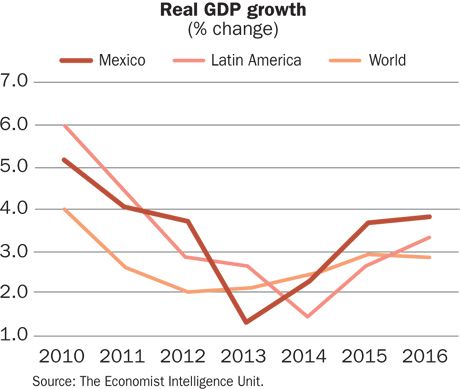
"When [...] Seguro Popular was approved a decade ago, we were aware that this was a mid-term reform and that the next step was the integration of the public institutions providing healthcare services in Mexico and the possibility of interaction with private care providers," comments Julio Frenk, former minister of health and currently dean at the Harvard T.H. Chan School of Public Health. After universal enrollment – today almost completed – the next step is universal coverage, which means access to a package of comprehensive healthcare services with financial protection. This is the stage Mexico is currently moving towards. As a matter of fact, over ten years the number of interventions covered by Seguro Popular has increased threefold, the amount of drugs included more than 300 percent, and the number of diseases included in the so-called fund for protection against catastrophic expenditures has been raised from four to 59. The last step would be universal effective coverage, which implies services are provided with a level of quality that ensures a successful effect on the patient as well as on society. Because as Enrique Ruelas, former president of the National Academy of Medicine, points out, "universal health coverage is about value, not only volume. If you don't introduce quality to the equation, you risk doing more harm than good."

Hector Valle, former general manager for Northern Latin America at IMS Health
The upcoming reform aims at creating a universal healthcare system under the concepts of portability of services and convergence. The idea is to give Mexicans the opportunity to use healthcare services at any institution, independent of their affiliation – a measure already approved for obstetric emergencies a couple of years ago to face the dramatic number of maternal deaths in the country. This will soon include a limited number of chronic-degenerative diseases, such as heart failure, diabetes, kidney transplants and HIV, among others, before moving on to cover more diseases over time. "Three main institutions cover more than 90 percent of our population: if we let people choose among those three options through universal healthcare coverage, this will lead to a healthy competition to see who can provide the best service. I see that as something extremely positive that can take our health care system to a whole new level," comments Guillermo Soberón, former minister of health.

José Campillo, president of FUNSALUD
However, a number of challenges stand in the way towards effective implementation of universal coverage. First, universal enrollment: while the Ministry of Health claims that full coverage is almost reached, Hector Valle, former general manager for Northern Latin America at IMS Health, argues that "studies carried out by IMS Health, the National Public Health Institute and the National Institute for Statistics and Geography (INEGI) indicate that around 20 percent of the population is still uncovered." Second, healthcare expenditure. Over the last decade, despite the number of Mexicans enrolled skyrocketing, total expenditure on healthcare increased from 6 percent to just 6.2 percent, well below the average 7.4 percent of other Latin American countries and the 9.3 percent average of OECD countries; on top of this, nearly half is still paid directly by patients. Additionally, the Ministry of Health recently announced a cut of nearly USD 650 million to the health budget, probably a consequence of the steep fall in oil prices, which is forcing many oil-producing countries as Mexico to review their federal budgets.

Maki Ortiz, president of the Health Commission at the Senate
A further hindrance is effective integration of different healthcare providers. "The systems and processes they are using today are completely different and separate. If you want to build an integrated system, you first have to standardize and connect the existing ones – something which is not happening yet," points out Valle. Last but not least, as José Campillo, president of the Mexican Health Foundation (FUNSALUD) argues, "we support increased participation of the private sector in the health sector through outsourcing of services and public-private partnerships. But there are still many questions about how this should happen."
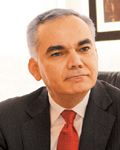
Gabriel O’Shea, national commissioner of Seguro Popular
The concrete methods to achieve effective integration, critical to create a working universal healthcare system, may still remain undefined; however, undoubtedly Mexico is moving in the right direction.

A roadmap to the healthcare reform
RAISING THE BAR
Creating the conditions to drive growth in the pharmaceutical sector has been the top priority of Mikel Arriola, head of the Federal Commission for the Protection against Sanitary Risk (COFEPRIS) and undisputed regulatory star of the sector. "I have always been firmly convinced that having an efficient and transparent authority could only generate growth in the industry you regulate," he notes. And since his appointment, back in April 2011, he has been walking the talk. Besides catching up on the backlog of 25,000 drug registrations left behind by the previous administration, the commissioner has pushed to cut the timeframe to authorize new medicines on the market from 360 to 60 days.

Rafael Gual, general director of CANIFARMA
But there are other jewels on the crown of Mexico's revamped regulatory authority for Arriola to boast about. The first is the long awaited recognition by the Pan-American Health Organization (PAHO) as a national regulatory agency of regional reference in July 2012. "The recognition was a milestone, because today drugs registered with COFEPRIS are recognized at international level. And this has helped local companies start exporting to other countries, especially to markets in Central and Latin America," explains Socorro España Lomelí, executive director of ANAFAM, the association that brings together local drug manufacturers. The second milestone came in June 2014 with the recognition by the World Health Organization (WHO) as a functional agency for vaccines for the 2014-17 period, which adds Mexico to the elite group of 28 players in this segment. "Taking into consideration the fact that only a limited number of countries worldwide have this recognition, it's definitely something Mexico can be proud of," acknowledges José Alberto Peña, vice president and general manager of GSK Mexico. "This recognition will allow the market to attract more local manufacturing to strengthen internal consumption but also position Mexico as an exporting country."

José Alberto Peña, vice president and general manager of GSK
"The recent reforms ensure the country offers today very different conditions for investment," points out Arriola. "At COFEPRIS we have included an added value, which is untouchable but very important: predictability and transparency." And the industry seems to welcome a stricter regulatory authority complying with international standards. Having raised the bar, now the priority of the industry seems to be getting the recognition it deserves. According to estimates of CANIFARMA, the national chamber of the pharmaceutical industry, today the sector represents 1.2 percent of Mexico's nearly USD 1.4 trillion GDP and 7 percent of the manufacturing GDP, second in importance only to the buoyant automotive sector. Rafael Gual, general director of CANIFARMA, has made it his personal objective to transform the pharmaceutical industry into the most important manufacturing sector in Mexico. "Besides the numeric objective, what is important is that we are working closely with the government to ensure the pharmaceutical sector is recognized as an increasingly important player in the economic development of the country," he notes.
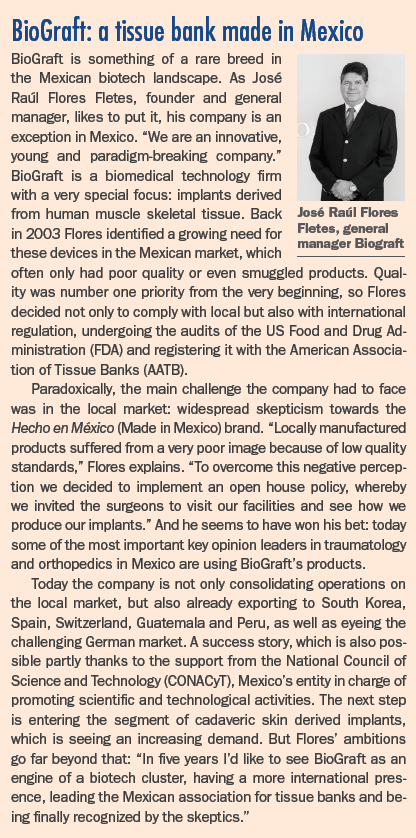
BioGraft: a tissue bank made in Mexico
The recognition of the national pharmaceutical industry as a key sector for Mexico's economy and population is also acknowledged by Socorro España Lomelí, executive director of ANAFAM, as one of the challenges of the association. "Mexican drug manufacturers are investing in the country and are fighting for it – and this should be recognized at national and international level." Alfredo Rimoch, general director of Liomont, one of the top Mexican players, shares this point of view: "the Mexican pharma industry is a strategic sector and does not get enough help from the government. We don't want government protection; we want support and those opportunities and incentives that are promoted by the government and granted to other industries, such as the automotive, and we still do not receive."

Socorro España Lomelí, executive director of ANAFAM
MEXICO: A MATURE PHARMERGING MARKET?
Almost ten years have passed since IMS Health listed Mexico – along with China, Brazil, Russia, India, Turkey and South Korea – among the seven 'pharmerging' markets promising above average prospects for growth. All markets shared common drivers such as an increasing government healthcare investment, a high level of out-of-pocket expenditure and an increasing burden of chronic diseases. Today Mexico is still viewed as an emerging market in terms of dynamics, but with growth rates that better resemble those of mature economies.

Alfredo Rimoch, general director of Liomont
"Many companies typically classify Mexico as an emerging market, although it is actually behaving as a mature one," points out Miguel Salazar, president and country managing director of the family-owned German company Boehringer Ingelheim. Pedro Galvís, managing director of another important German player in Mexico, Merck, shares the same view: "Despite being considered an emerging market, Mexico resembles a mature market in several aspects. It's a double-edged sword sometimes, because expectations from headquarters are high as Merck Mexico grows at a double-digit rate; however, the market does not." Besides growth rates, an increasing participation of the government is also impacting performance, as "we are witnessing a trend towards switching out-of-pocket and retail to a more institutional market," adds Galvís.

According to IMS Health, by the end of 2013 the pharmaceutical market in Mexico was worth nearly USD 15 billion, with a compound annual growth rate of approximately 6 percent in the 2009-13 period, but only a modest 3 percent growth in 2013 and less than one percent in 2014. While offering opportunities from an ageing population, a changing epidemiological profile and expanded healthcare coverage, the market also feels the strain of several factors, which include the government's push to drive down prices, an increasing penetration of generics and, consequently, diminishing brand loyalty among consumers. Moreover, the fiscal reform implemented at the beginning of 2014, combined with the annual inflation breaking the four percent ceiling set by Mexico's Central Bank, hit consumers' purchasing power – all important changes in a market where nearly half of the health expenditure is out-of-pocket.

Miguel Salazar, president and country managing director of Boehringer Ingelheim
Since 2012 the government has made it a priority to improve the access of the population to a well-supplied drug market that offers medicines at the most affordable prices. Aligned with this policy, the regulatory authority implemented a strategy to facilitate the approval of generic drugs. Since then, 31 active substances have entered the market and 287 new generic drugs were registered, dramatically increasing generics penetration. Today, with an 84 percent volume share, Mexico is the second market in the world for penetration of generics behind the US.

Pedro Galvís, managing director of Merck
"The whole pharmaceutical industry has done a lot to inform patients about bioequivalence, to make sure they understand that a generic drug is the same as an innovative one and that they represent a cheaper option for treatment," explains España Lomelí of ANAFAM. "People's mindset towards generics has been changing and an increasing number of Mexicans are now aware that generic products are just as good as brands," points out Andrés Aguirre, strategy director of Grupo Bruluart. "Sometimes it is also a matter of not having a choice. When people cannot afford to buy branded products, they try generic versions only to realize they work just as well. This means that from that moment onwards, branded products are not an option anymore," adds his brother Juan José, sales director of the group.
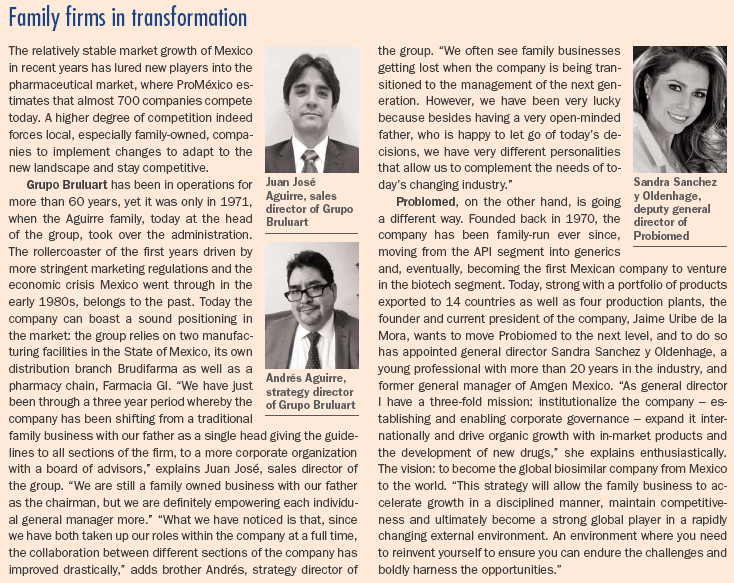
Family firms in transformation
So it comes as no surprise that, despite the meager overall market growth in 2014, local, mainly generic-driven, players have showed the best performance in the retail market, with a more than 6 percent year-on-year increase. Large product portfolios, volume-driven agreements, integrated distributors and strong bounds with the public sector help them outpace big pharma.

Cristóbal Thompson, executive director of AMIIF
ACCESS IS THE NAME OF THE GAME
So, given the skyrocketing increase in the penetration of generics, where does innovation come into the equation? Apparently it's a common concern for big pharma. "Ensuring that new products get to end consumers is one of the biggest challenges that we are facing as an industry at the moment," points out José Alberto Peña, vice president and general manager of GSK Mexico.

Alexis Serlin, country president of Novartis
According to an IMS Health study carried out in 2014, in Mexico it takes up to 4.3 years for a new treatment to be listed in the public healthcare sector, compared to two years in the UK and Japan, and 3.4 years in Brazil. "Drug access at Mexican public healthcare institutions is currently the main issue for all multinational companies," explains Pedro Galvís, managing director of Merck, "I think this is where both the opportunities and challenges lie. The government has made important efforts to expand coverage to the over 112-million population and this makes us optimistic. But we are still far from being a country where people have access to medical innovation." Again, COFEPRIS has taken important steps over the past years in order to improve the situation, also including innovative drugs in its access strategy. Whereas in 2010, before the Arriola administration, only three new molecules were approved, "between March 2011 and August 2014 we have issued 133 new molecules, which account for 20 different therapeutic classes that represent 73 percent of the mortality causes in the Mexican population, namely chronic diseases," points out the federal commissioner. "Moreover, we are now authorizing new drugs within 60 working days, which has helped transform Mexico into the global launch country for four new molecules (two for asthma and two for diabetes) and the dengue vaccine."
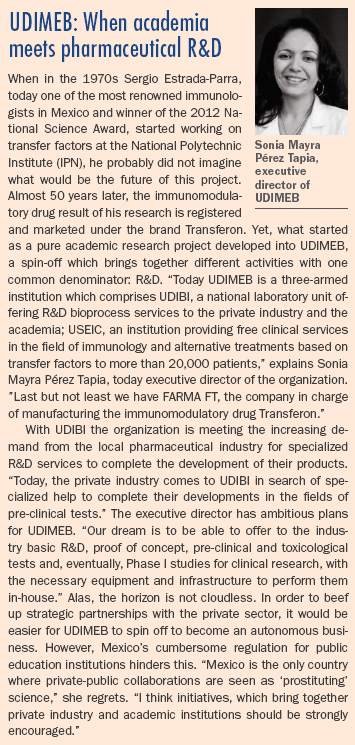
UDIMEB: When academia meets pharmaceutical R&D
Alas, the problem does not lie within the regulatory authority. After a drug gets the approval from COFEPRIS, it still has to pass the General Health Council to later be approved through each and every one of the healthcare providers, i.e. IMSS, ISSSTE, Seguro Popular, the Army, the Navy, etc.

Karel J. Fucikovsky, general director for Mexico and Central America at Pierre Fabre
Upon his appointment as executive director of AMIIF, the association bringing together the most important research-based pharmaceutical companies, Cristóbal Thompson, made it his "personal mission to move AMIIF from being a stand-alone organization which only represented the interests of its members, to being one integrated in the healthcare sector and a meaningful actor able to sit down with the government to discuss how to improve the health system as a whole." The result of this effort is a document called 'AMIIF 2024', which pictures the Mexican health system in ten years. "We realized that if access was the most important problem, we needed to start addressing it," he continues. "Especially in the case of non-communicable diseases, waiting times are unacceptable for patients and make the country lose competitiveness. Even though Mexico is the 13th largest pharmaceutical market in the world, why should a chairman consider it a priority if access is not granted? Today access is the name of the game."

Ugo de Jacobis, president and general director AstraZeneca
To find a trade-off between innovation and affordability, drug makers are increasingly looking for a collaborative approach with the government. "Drug access is a shared responsibility between the private and public sector. Fortunately the collaboration with the government and authorities has improved over time and today there is a much more open dialogue to define how to make innovation available at public institutions," points out Ugo de Jacobis, president and general director of AstraZeneca. Alexis Serlin, country president of Novartis Mexico, confirms that "drug access is high on the agenda. Thus, we are partnering with the Ministry of Health to make sure innovation gets to patients in an economically efficient way for the government." Peña at GSK shares the same view: "From an industry perspective we have been trying to understand the difficulties the government is facing and opening a dialogue to find mechanisms to fix pricing to work together and make drug access possible," and adds that "it is important to create the dialogue and make it happen."

Carlos Abelleyra Cordero, CEO for Spanish Latin America at Aspen
NAVIGATING THE NEW RETAIL ARENA
Two important trends are shaping the pharmaceutical retail scenario, forcing local as well as international companies alike to rethink their go-to-market strategies. First, a reconfiguration of the retail segment with the consolidation of pharmacy and supermarket chains and the market entry of new players; and second, the presence of physicians at points of sale.

José Manuel Caamaño, general manager of Takeda
According to IMS Health, chains and supermarkets went from holding 45 percent market share in 2008 to 59 percent in 2013. By mid of 2014 three pharmacy chains – Benavides, Farmacias Guadalajara and Farmacias del Ahorro – controlled almost 90 percent of pharmacies in the country and are increasingly becoming a preferred option for customers. The recent announcement of drug store retailer Alliance Boots' acquisition of Farmacias Benavides as well as the market entry of non-pharmaceutical retail players such as Femsa, owner of Mexico's leading convenience store chain Oxxo, indicates the segment offers interesting growth perspectives and may bring in new business practices.

Juan José Davidovich, general manager of Sifi Group
The apparently incessant growth of big pharma chains may also force wholesalers to reinvent themselves, especially after the collapse of one of the historic players, Casa Saba, which declared bankruptcy at the beginning of 2014. "We have shifted from a distribution model with a small number of large wholesalers to a system with a small number of large pharmacy chains," points out Americo García, general director for Northern Latin America at Apotex.
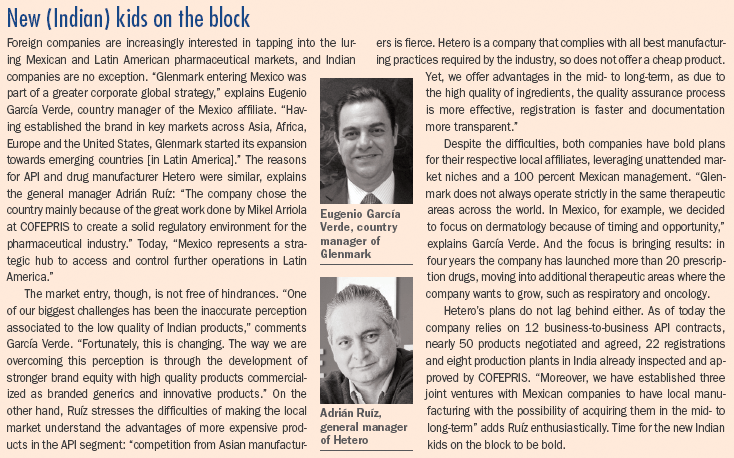
New (Indian) kids on the block
However, the real big game changer in the industry are physicians at the point of sale. Karel J. Fucikovsky, general director for Mexico and Central America at the French drug maker Pierre Fabre, thinks "the emerging power of physicians at the different points of purchase and pharmacies is a trend pretty unique to Mexico and the Latin American region and growing incredibly at the moment." And the numbers confirm Fucikovsky's belief. According to COFEPRIS, out of the nearly 28,000 pharmacies that exist in Mexico today 54 percent offer medical consultation, 340 percent more than in 2010. Also, IMS Health estimates that pharmacies provide over 250,000 medical visits on a daily basis – an impressive number considering IMSS provides nearly 290,000. "This has been a phenomenon that no one in the past has been taking into account very seriously, but that will eventually make pharmaceutical companies refocus their strategies to understand this dynamic and emerging market, as to better work with it rather than against it," concludes Fucikovsky.
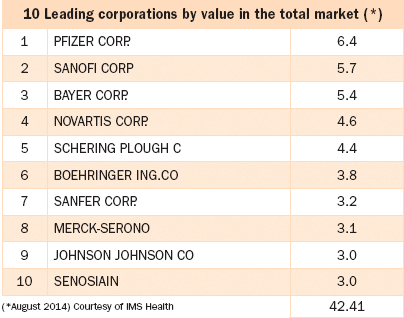
10 Leading corporations by value in the total market (*)
Opinions on the presence of physicians at the point of sale are split within the industry. On the one hand, many think it represents unfair competition, as doctors tend to prescribe store brands. In today's retail scenario "the point of sale plays an increasingly important role in the business equation," points out Carlos Abelleyra, CEO for Spanish Latin America at Aspen. "The prescription switching pharmacy chains are doing from branded generics to private labels is huge and it is challenging to assess, as it is not audited. And this is jeopardizing the price strategy companies have at normal pharmacy chains." Rafael Gual from CANIFARMA warns against the practice as well. "The trend is here to stay, it is a necessary evil. We must remember a medical consultation at a point of sale is far from being equivalent to one at a medical institution." On the other hand, many think it can help diminish the chronic habit of Mexicans towards self-medication, while it unburdens the public healthcare system and fosters prevention.

Rafael Suarez, country manager Ferring
And more changes can be expected in the turbulent medicine retail arena. José Alarcón Irigoyen, partner and leader of the Healthcare Practice for Mexico and Hispanic America at PwC, thinks the industry can even expect more disruptive approaches: "The innovation may come from looking at alliances with hospital chains and retail chains with point-of-sale physicians to act together as a new player and offer an integrated healthcare delivery network, whereby the physician at the pharmacy will reference the patient requiring further attention to a clinic of this network through a financial model based on micro-insurances complemented with a model to manage the health of such citizens in an integrated way." Only time will tell.

BIGGER FOOTPRINTS
Besides a stable business environment and optimistic outlook, Mexico offers companies in the pharmaceutical arena an additional advantage: manufacturing cost competitiveness. According to the 2014 BCG Global Manufacturing Cost Competitiveness Index, average direct manufacturing costs in Mexico are 4 percentage points cheaper than China's, with the country's overall cost structure presenting the best improvement among the 25 economies in the index. The same is true for the pharmaceutical industry. According to KPMG's 2014 Competitive Alternatives report, in 2014 Mexico's manufacturing costs for the pharmaceutical industry were 14.4 percent cheaper than the US.

Raúl Vivar, head of Shire Mexico, Central America and Caribbean
For this reason an increasing number of companies in recent years have announced significant investments to strengthen their local footprint in the country. In the effort to ramp up manufacturing operations to meet increasing international demand, Takeda has chosen Mexico for its cost competitiveness and is currently upgrading its local infrastructure. "The Takeda Mexico plant started operations in 1961 and has had two large renovations since then. Today, it exports to 16 countries including Colombia, Argentina, Peru, Ecuador and Venezuela. It has certifications from COFEPRIS, Safe Company from the Ministry of Labor, Clean Industry from the Federal Attorney for Environmental Protection (PROFEPA) and INVIMA from Colombia, in addition to several, continuous audits," explains José Manuel Caamaño, general manager of the Mexican affiliate. "For the past nine months, our plant was completely refurbished to become a best-in-class plant with top technology and high-quality staff." The local footprint has also helped the company have the flexibility to better adapt to the local needs of the market. "We have developed a product portfolio specifically tailored to the country: The four areas we will be focusing on locally are primary care and high specialty, with treatments in the therapeutic areas cardio-metabolic, oncology and gastrointestinal. Takeda Mexico has successfully launched eleven products in three years in Mexico. We are definitely committed to bringing innovative products for a better health of our patients."

Elvin Penn, general manager of Amgen
Yet, advantages go well beyond cost competitiveness. "We compete not only with regional, but also with international production sites at a global level. The level of productivity we can achieve in this type of environment is high thanks to the lower cost of manufacturing, but also due to the level of human capital available – Mexico offers the right mix," points out Pedro Galvís at Merck, which in 2013 announced an investment of USD 10 million to increase the manufacturing capacity of the local subsidiary. "Having manufacturing located here in Mexico gives us flexibility and it pays off – we have one of the most competitive manufacturing costs worldwide."
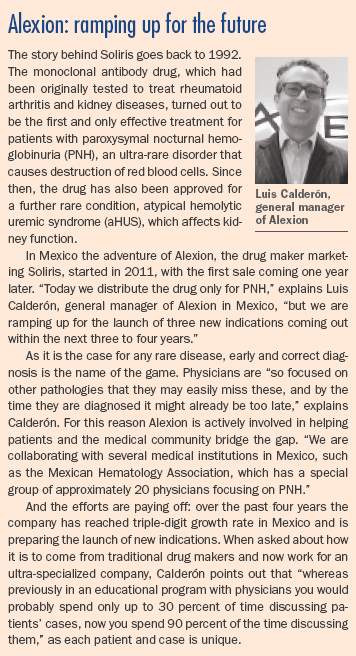
Alexion: ramping up for the future
Aspen is also betting on Mexico. The South African giant is decided to transform Latin America into the third pillar of success for the group, after its origin country and Australia – and has decided to leverage local production in Mexico to do so. To make this happen Aspen appointed Carlos Abelleyra Cordero, with more than 20 years of experience in the industry, CEO for Spanish Latin America. Former general director for Wyeth Mexico and Central America, today Abelleyra is charged with the mission of successfully integrating the infant nutrition business Aspen acquired from Nestlé back in 2013. "When I was appointed CEO I knew the goal was to lay the foundations to create Aspen Latin America – and that's what we are doing." Part of the deal included the acquisition of a production facility in Mexico the South African drug maker plans to use to penetrate the region. "We plan to invest USD 20 million to double the current production capacities. In the mid- to long-term the idea is to have a full pharmaceutical production plant based here, which can be a hub for the region." What stands out about the adventure of Aspen in Latin America is that the company is going a different way. "Aspen used to be a 100 percent generics company, and in South Africa and Australia it still is. But in Latin America the generics space faces fierce competition from local manufacturers and prescription still represents an important purchasing driver, so we decided to adapt to the local scenario and change the strategy from a basket to a therapeutic area company." And the long-term objectives are ambitious, as Abelleyra plans to achieve USD 1 billion regional sales by 2020.
Also the Swiss specialty biopharmaceutical group Ferring is going the same way. "The company has a very clear idea about where they want to be – globally, regionally and locally," explains Rafael Suarez, country manager of the Mexican affiliate. "To strengthen its commitment to Mexico – the second market in the region after Brazil – back in 2008 Ferring bought a manufacturing facility in the State of Mexico, where we repackage imported bulk products for the local market as well as for Ferring subsidiaries in Central and South America."
Boehringer Ingelheim, which is turning 130 in 2015, has also announced the intention to scale up local operations. "Since 1995 Mexico has been appointed a strategic production site by the corporate," explains Salazar, who in May 2014 announced the company's plan to invest nearly USD 26 million to increase production capacities in Mexico. "We are also planning to convert Mexico in a hub for the manufacturing of diabetes products to then distribute them to the whole world."
Besides cost competitiveness, also other factors have encouraged companies to strengthen their foothold in the country. Mexico today is one of the most open economies in the world with 45 free trade agreements in place and currently negotiating the Trans-Pacific Partnership (TPP) with other eleven countries of the Asia-Pacific region. It is the case of the Italian ophthalmology leader Sifi Group. "We looked at countries such as Chile, Brazil and Peru as a new base to enter the Americas, taking into account market dimensions, language barriers, cultural differences and facilities," explains Juan José Davidovich, general manager of the local affiliate. "We soon identified an ease of business in Mexico and decided to look for a partner here." And the ambitions for the group in Mexico are high. "The role that Mexico will play for Sifi, will be that of a hub to enter Central and South America," explains Davidovich. "This because of Mexico's agreements with other Latin American countries such as Chile and Colombia, which will greatly facilitate our operations in the region."
RARE IS THE NEW FOCUS
According to the Mexican Organization for Rare Diseases, seven million Mexicans suffer from a rare condition, defined as one that affects less than five in 10,000 of the general population. "Physicians do not normally have these types of diseases in mind and their procedures and testing are not always adequate," explains Raúl Vivar, head of Shire Mexico, Central America and Caribbean. The challenges related to diagnosis are even higher when it comes to ultra-rare diseases, as it is the case of paroxysmal nocturnal hemoglobinuria (PNH), a condition in which red blood cells break down earlier than normal. "In case of rare diseases we are talking about five in 10,000 people. But in case of ultra-rare diseases it's five in a million," points out Luis Calderón, general manager of Alexion in Mexico" Early recognition of ultra-rare diseases is still a challenge. The probability for a physician to meet such a patient is very low. It's something, which is not their everyday, so we need to make them think out of the box."
Access to treatment is also a hurdle patients face in Mexico, as it depends on the healthcare provider they are affiliated with. "Fortunately our products for lysosomal diseases are all available at the different public institutions. However, the situation is different at every healthcare provider," explains Vivar. The public insurance scheme Seguro Popular, due to budget constraints, only covers patients who start treatment before the age of ten and only at a very limited number of certified hospitals across the country, which in turn imply a burden of costs for patients and their families. At the Mexican Institute for Social Security (IMSS), on the other hand, the main hindrance is the time between diagnosis and beginning of the treatment, which can span up to 18 months –too long for such a life-threatening condition.
Good news is that in recent years Mexican health authorities have shown an increasing openness towards recognizing the importance of correctly diagnose and treat rare diseases. The first step was a change implemented to Article 224 of the Health Law in 2012, which officially acknowledged the existence of orphan drugs, and thus rare diseases. The regulatory authority COFEPRIS has also shown an increasing concern with the treatment of rare diseases and since 2012 has granted market access to 19 new orphan drugs. This renewed openness has attracted new international orphan drug companies, such as Celgene, Eisai and BioMarin, to enter the Mexican market and to bring together stakeholders to make sure these conditions receive the correct recognition. "A problem of this magnitude has not an easy solution and should be addressed by different stakeholders, such as physicians, patient organizations, education institutions, public healthcare providers," adds Vivar. "To make sure we can raise the necessary awareness we are starting collaborations with different parties such as the Mexican Association of Pharmaceutical Research Industries (AMIIF) and other drug companies focusing on rare diseases."
With the recent opening of IMSS to clinical research, the Mexican market is also very interesting in terms of R&D in this field. Amgen envisioned this almost a decade ago, when the company decided to establish its first affiliate in Latin America in Mexico. "What started back in 2006 as an R&D hub intended to cover the rest of Latin America has received over the last eight years an investment of over USD 22 million in clinical research," explains Elvin Penn, new executive director and general manager at the Mexican affiliate. Today the company has 21 clinical trials running at leading research institutions in Mexico and plans to keep generating clinical data in the country for local as well as global registration processes.
